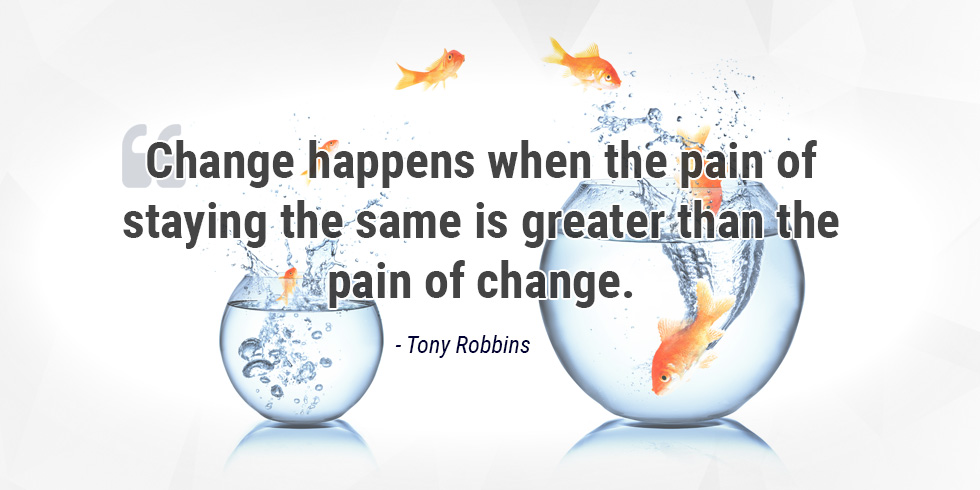Famed life coach and author, Tony Robbins remarked that “change happens when the pain of staying the same is greater than the pain of change.”
Changes can be large and small, but as Mr. Robbins suggested change is motivated by the desire to make things better.
Movin’ on Up
For my family, the topic of change has been top of mind for the past year. About a year ago, we made the decision to pull up stakes and move to another state. Starting over socially, in new schools and jobs, and in a new weather climate are tough. As a southerner who’s moved north, I am lost without sweet tea. Folks, it’s a problem! If you’ve lived this experience, you know that a lifestyle change of this magnitude is not easy!
I knew there was a risk that we might not find a new community that was as welcoming as the place we had called home for a decade in a state that I had lived the majority of my life. We felt the promise of new opportunities outweighed the pain of building new relationships in a city that was unfamiliar to us. I’m glad we decided to step outside of our comfort zone.

Today, we’re certain that the decision was right for us. The temporary discomforts of packing and unpacking boxes, changing mail addresses, and searching for local services has largely passed. We’re living an exciting new life that challenges us to do our best, every day. That’s what counts the most.
These personal experiences make me think about my life as a business consultant. I’ve often challenged E&A customers to make changes to their enterprise resource planning (ERP) systems, both large and small, in an effort to make things better. In life as in business, the goal is to raise the bar, right? But it would be unreasonable to think that implementing change is any easier for business people than it is for individuals.
Managing Change in Pieces

It’s usually not difficult to find a reason to change your ERP system for the better. End users have cited any number of desirable attributes that have driven their upgrade decisions to me. These include the improved employee productivity and efficiency that comes with expanded system feature/functionality; as well as, the automation of routine tasks, better management reporting tools, and enhanced system security, to name just a few.
With so many possibilities, there’s no wonder that expectations for the ERP upgrade often runs high. Some users expect more, some expect less; but if the implementation does not deliver to everyone as anticipated, the decision to upgrade can come up for criticism.
That’s why I believe it’s helpful to break things down into manageable pieces. Let’s start with a high-level understanding of what your management team wants to change. Pre-work in the form of end user surveys or internal discussion forums by the functional areas of your business can be useful. The outcome of these discussions and surveys should be a priority for a distributor prior to engaging in an upgrade project.
This list serves you in a couple of ways. You can compare features in the ERP with your specifications and learn if modifications may be indicated. As we move through the list from the most to least important items, we can thoroughly address your business needs in a methodical and organized fashion.
At a high level, I’ve found that more and more decision makers want to implement Business Intelligence (BI) and eCommerce as part of the ERP upgrade. The inclusion of these applications on the to-do list can significantly enlarge the scope of your implementation and the number of people required to execute this project successfully. It’s important to allocate time for strategic planning and discussion to help ensure that the technology will deliver on its promise.
ERP projects are composed of software and associated processes. If you’re upgrading an existing ERP, it might be comforting to know that the data remains the same as before. Mostly, change pertains to end user processes, capability and capacity. As has been suggested before, more often than not these changes are merely incremental. However, it’s possible that some functional areas of your business will change more substantially and thus require more extensive training.
As we drill down to how individual end user processes might need to change, we may also want to evaluate your existing software modifications. An ERP upgrade can provide a terrific opportunity to streamline processes and programs that are no longer needed. Whenever the new-and-improved ERP is able to support the functionality you need, your company benefits.
You Can Do This!

For many companies, the question of who can lead the organization through change can be tough. A delegation challenge can arise due to current obligations. When you are already pressed to serve the needs of customers, vendors, shareholders, and employees, who among your staff can be dedicated to an ERP project?
The answer is that change is not any one person’s responsibility. To get results across your business enterprise, a team effort is required. It’s important that the message of shared responsibility gets communicated by your leadership team.
A good place to start is a message about the importance of change to the company’s long-term success. When everyone has gained a shared vision of success, you will reduce people’s natural inclination to resist change. In fact, your employees can become energized with the knowledge that an upgrade promises shared benefits to the company including greater teamwork, job satisfaction and prosperity.
As I’ve said, leadership’s championing of change is critical to achieving buy-in throughout the organization. After all, leadership takes ultimate responsibility for the project’s success or failure. The best project plans can fall short if management has not fully committed its employees to support the task at hand. It’s also management’s responsibility to monitor progress towards goals and make adjustments when necessary.
Working with Change Agents
Successful change management implies that your company will be in a state of flux for a period of time. You should ask the same of your prospective business partners. After all, you’ll be collaborating very closely with the vendor for the duration of the project. You should want to work with companies who are proven change agents.
Does the vendor have an internal champion who will assure that it’s as committed to the project as you are? Has its leadership team taken responsibility for the consultants who will be working closely with your team? These are important questions to ask.
As we’ve discussed, change is not easy. As a person who’s disrupted his life to move to a new city, I can definitely relate! But just like my personal life has been enriched by the opportunities afforded by new horizons, I believe your business can be richly rewarded by the effort.














